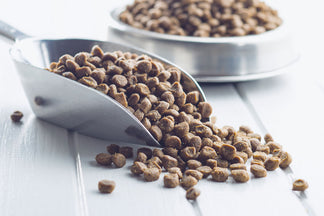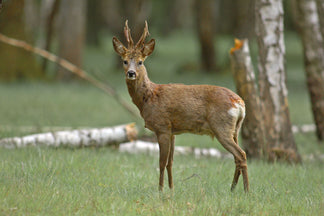Determining how many calories a dog burns each day is crucial for knowing how much to feed a dog. When people are unsure of how many calories their dogs really need, they tend to overfeed, which can cause a multitude of health problems for their dogs. In this post, we will present basic formulas used to estimate calorie requirements for your dog and provide some specific examples as reference points. These formulas and calculations are used as generic estimates of required calories, and are based on the Waltham Center for Pet Nutrition (WCPN) (http://www.waltham.com/) studies.
According to the Waltham Research, the formula for the daily calorie requirement for an inactive adult dog is the following:
CR (kcal/day) = 90 • Bodyweight(0.75)
Where CR = daily calorie requirement for a dog
and
Bodyweight = weight in kgs ~ weight in lbs/2.2
For example, if you had an inactive dog weighing 25 lbs., their CR would be equal to:
90 • (25/2.2)0.75 = 557 calories/day to maintain their 25 lbs.
In practice, this means that you should feed this dog 557 calories worth of food each day in order to maintain a 25 lb. weight because they will burn about 557 calories per day.
For the adventurous types, the table below from WCPN shows the CR formulas for other categories. Note that the more active is the dog, the higher the multiplication factor is, and consequently the higher the CR.
| Category | Type of Activity | Daily Calorie Requirement (CR) | |
| Duration | Intensity | ||
| Inactive/Senior | < 3 hr/day | Low | 90 • Wtkg(0.75) |
| Typical | < 3 hr /day | Mainly Low | 110 • Wtkg(0.75) |
| Active | 1-3 hr/ day | Mainly High | 125 • Wtkg(0.75) |
| Highly Active | 3-6 hr/day | High | 175 • Wtkg(0.75) |
One of the problems with the Waltham approach is that it uses fairly wide ranges for activity duration for a given category of pet. For example, a typical dog is said to exercise for less than 3 hours per day. However, the number of calories that a dog will burn will be different if they exercise for 30 or 90 minutes (both of which are less than 3 hours).
Calories for Weight Loss
No matter how active your dog is, their weight has a major influence on their daily calorie requirement. The bigger they are, the more calories they require. If you want your dog to lose weight, a safe way to figure out how many calories to feed your dog is to use their desired weight in the calorie calculation, then use ¾ of this value until they reach their target weight. Here's an example.
Say that in our prior example (25 lb. inactive dog), the dog was 5 pounds overweight, so he really should be 20 pounds. To get this dog safely to 20 pounds, we would calculate the CR for a 20 pound dog, which is equal to about 470 calories per day. This will be the dog’s daily calorie requirement when they attain the target weight.
While the dog is in weight loss mode, feed ¾ or 75% of this amount, or about 350 calories. The same approach applies if you are trying to increase your dog’s weight, in which case you would feed at 125% of their target weight calories until they attain their goal.
Quick Rules of Thumb
For those who don’t want to break out the calculators, below is a table that shows an estimate of how many calories per pound of body weight dogs of different activity levels would need.
| Approximate Calories Needed per lb. of Body Weight | |||
| Small Dogs | Medium Dogs | Large Dogs | |
| (< 20 lbs.) | (20 - 50 lbs) | (> 50 lbs.) | |
| Inactive | 25 | 20 | 17 |
| Normal | 32 | 24 | 21 |
| Active | 35 | 27 | 24 |
Other Considerations
There are many other factors that can also impact the number of calories that your dog will burn each day. These include:
-
Dogs age (puppies burn a ton of calories!)
-
Pregnancy (so do soon-to-be-moms!)
-
Certain medical conditions
-
Surgeries
-
Trauma
Sorry for all of the math today, but there's no way around it. Let us know if you have any questions about it by posting in the comments or using our contact form. We have a lot more to say about calories including the relative calorie burns for different types of activities.
Reference: Waltham Centre for Pet Nutrition. (1999). Canine life stages/lifestyles. Waltham Course on Dog and Cat Nutrition [On-line]. You can find this paper here: http://www.bearscampnewfs.com/health/Waltham%20Center/Canine%20Life%20Stages-Lifestyles.pdf

 Food
Food
 Food
Food
 Food
Food
